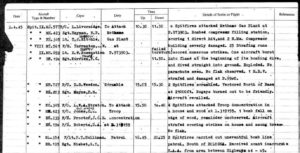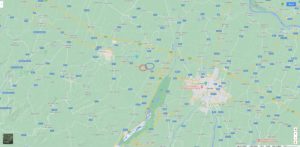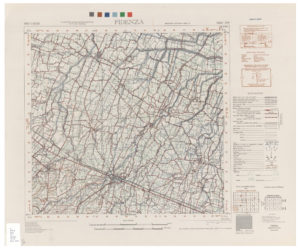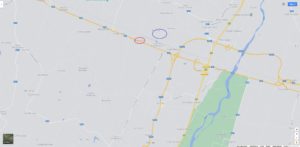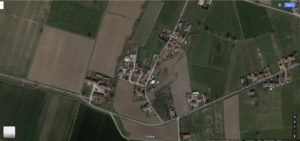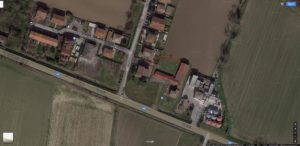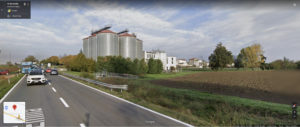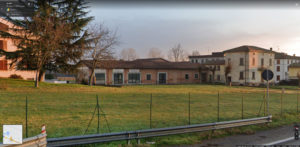The story of Willy Rosenstein has been told.
This is the story of his son: Ernest Willy Rosenstein.
 Named after his grandfather, Ernest Willy was born on in Stuttgart on February 20, 1923. His mother, Hedwig (Rothschild) Rosenstein, born in Stuttgart on December 1, 1892, was the daughter of Samuel and Ida (Levi) Rothschild.
Named after his grandfather, Ernest Willy was born on in Stuttgart on February 20, 1923. His mother, Hedwig (Rothschild) Rosenstein, born in Stuttgart on December 1, 1892, was the daughter of Samuel and Ida (Levi) Rothschild.
Hedwig died in that city on June 8, 1926. This had a devastating impact upon Willy, causing him to fall into a state severe depression which he alleviated with drugs and morphine. However, as a single father and aware of his responsibility for his young son, he sought aid, and successfully recovered.
Willy subsequently married Paula Levi (born in Stuttgart on April 5, 1904), the daughter of Julius and Julie (Steiner). Though not mentioned at the Alemania Judaica website, Willy’s marriage to Paula brought with it the adoption of her son, Peter Emil Julius Blum, from her previous marriage to Joseph Blum.
The exact date of the family’s emigration to South Africa is unknown.
In any event, Paula left Willy in December, 1939, taking Peter with her. This very deeply affected Willy, but once again he recovered, albeit with great struggle. (Paula later married Herman David. She died in London in February of 1975.)
A subsequent blow to Willy was his internment by the Union of South Africa, as “a possible enemy of the state” in June of 1940. He was interned at Camp No. 2, Ganspan. The length of his internment is unknown, but this definitely continued through early 1942, for Ernest Willy’s Attestation Papers, completed in Johannesburg on March 10 of that year, list his father’s address as Internment Camp No. 1, Post Office Jagersfontein, in the Orange Free State.
Presumably – likely – Willy was released from internment by mid-1945, for the “Roll of Honour” entry for Ernest Willy published in the South African Jewish Times on May 17, 1945 (listing South African Jewish servicemen killed, wounded or injured, or released from POW camps) gives his father’s address as Mountain View, Post Office Rex, Rustenberg, Transvaal. This same address appears in a comprehensive list of South African Jewish military casualties published in the same newspaper on September 7, 1945.
As for Ernest Willy? His Record of Service Reveals that he attended the Realgynmasium in Stuttgart, Hofoberkirch High School in Switzerland, and then Dillman and Parktown High Schools in South Africa. Interested in aviation early on, he worked at the Rand Airport, in Germiston, as an air mechanic for Air Service Pty. Ltd. Unsurprisingly, he was multilingual, speaking English, Afrikaans, and German – the latter fluently.
Ernest Willy entered the South African Air Force in March of 1942, and was assigned to No. 75 Air School, at Littleton. Commissioned a Second Lieutenant (serial number 328895V) on October 9, 1943, his subsequent postings included:
ME (Middle East) Pool – Assigned to Royal Air Force (November 2, 1943)
No. 1 (ME) (Middle East) ARC (Aircrew Reception Centre) (November 5, 1943)
No. 73 Operational Training Unit (Abu Sueir, Egypt) (December 4, 1943)
No. 22 PTC (Personnel Transit Centre) (February 26, 1944)
Tunis Base Area (March 1, 1944)
DAF (Desert Air Force) (May 1, 1944)
Mediterranean-Middle East Communications Squadron (Bari, Italy) (March 9, 1944)
No. 242 Squadron (Poretta, Corsica; Frejus airfield, Riviera; Montelimar, France) (June 19, 1944)
No. 3 BPD (Base Personnel Depot) (September 29, 1944)
No. 5 RFU (Refresher Flying Unit) (October 6, 1944)
…and finally…
No. 185 Squadron (Fano, Florence, and Pontadera, Italy) (October 22, 1944)
His military awards comprise the Italy Star, the 1939/45 Star, 1939/45 War Medal, and Africa Service Medal.
______________________________
Photographs
The four images below were scanned from photocopies made by Robert Gill. I assume that the original images were among Willy’s First World War photo scrapbooks, the latter of which Robert received from Jules Loth in the 1980s.
______________________________
Ernest Willy in his officer’s uniform.
 Another portrait, this time with a distant look.
Another portrait, this time with a distant look.
 ______________________________
______________________________
Ernest Willy, seated in the cockpit of Naomes II, a Spitfire IX which he flew while assigned to No. 242 squadron RAF. The aircraft carried the squadron code “LE * P”, buts its serial number is unknown. According to Ernest Willy’s Pilot’s Log Book, he first piloted Naomes II during a sweep of the Bologna area on June 30, 1944. The plane was lost while being flown by John Barry Ware August 16, when the engine cut on take-off. So, the image can be dated from July through mid-August of 1944.
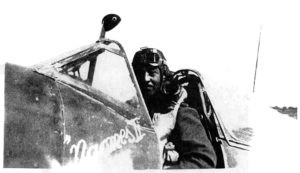
But, who was Naomes? That will likely remain a matter of conjecture…!
______________________________
Ernest Willy and two comrades before a Spitfire IX.
 ______________________________
______________________________
Ernest Willy’s matzeva at the Milan War Cemetery in Italy (plot location V, A, 5) photographed by FindaGrave contributor and76.
 ______________________________
______________________________
Ernest Willy’s Final Mission
An inquiry to the Ministry of Defence (Lacon House Theobald’s Road) concerning Ernest Willy’s last mission, on April 2, 1945, brought this reply from Mr. Eric A. Munday of the Air Historical Branch:
“Our records show that Lieutenant Rosenstein was the pilot of Spitfire MH892 which was on an air operation (dive bombing) of a methane gas plant at Fontana at about 1100 hours on the day in question. His aircraft was seen to crash just west of the target.
“Lieutenant Rosenstein was badly injured on the crash and he died in the local hospital a few hours later. He was originally buried in a local cemetery, but after the war he was buried in a British Military Plot in a cemetery in Milan.
“Eyewitnesses stated that Lieutenant Rosenstein made a last-minute attempt to bail out, but apparently he was too low for his parachute to deploy properly.”
Within the No. 185 Squadron ORB (Operations Record Book), the Record of Work Carried Out for the mission simply states: “One aircraft burst into flames at the beginning of its bombing dive, and dived straight into ground. Exploded. No parachute seen. No flak observed.”
Similarly, the No. 185 Squadron Summary of Events notes: “Six Spitfires led by P/O L. Liversidge attacked METHANE Gas Plant at P.973903. Bombed Compressor filling station scoring one direct hit and two near misses. Compressor building was severely damaged. Twenty-five strafing runs were made and numerous strikes were scored. One aircraft piloted by Lt. E.W. Rosenstein burst into flame at the beginning of its bombing dive and dived straight into the ground and exploded. No parachute was seen and no flak was observed.”
A question…
…the discrepancy between the report of Ernest’s attempt to parachute to safety (quoted from his Casualty File) versus the absence of such an observation in the squadron records, let alone the absence of anti-aircraft fire, lends a mystery to the story. I have no knowledge about WW II RAF single-engine fighter dive-bombing tactics in the MTO – particularly in terms of the altitude from which an aircraft would “pitch over” into its dive – but could MH892 have been struck by small arms fire; a terribly unlucky shot, which might not have been visible to other pilots?
Another question…
Who were the eyewitnesses who observed his bail-out attempt? Italian civilians? German soldiers?
And, another…
Where is Fontana, as mentioned in Mr. Munday’s letter? The ORB gives the target location via military map coordinate “P.9783903”. I have been unable to identify an Italian town specifically named “Fontana”, but there is a commune (municipality) in the Friuli-Venezia Guilia region (northeastern Italy) by the name of “Fontanatredda”. Could this be the “Fontana” of April 2, 1945?
______________________________
A Fleeting Historical Record
Certainly Willy and his son exchanged correspondence with one another throughout the latter’s wartime service, but given the passage of time; given the fact that Ernest Willy had no siblings; given the apparent absence of other family members, it would seem that this invaluable documentation has long been lost.
So, while Willy Rosenstein’s life has been well-documented, fate accorded no such recognition to his son. Still, published records about Ernest Willy, however brief, however few, do exist…
The first seems to have been in the South African Jewish Times, which – like many other Jewish news periodicals the Second World War – published casualty lists both during, and even for some time after, the end the conflict.
And so, on May 17, 1945, Ernest Willy’s name appeared in the newspaper’s “Roll of Honour”.

 Some other men on the list include:
Some other men on the list include:
Killed
Greenberg, Harry Noel, Lieutenant, 206825V, Transport Pilot
Royal Air Force, No. 28 Squadron
Mrs. Maureen M. Greenberg (wife), 226 Jan Smuits Ave., Dunkeld, Johannesburg, Guateng
Mr. and Mrs. Harry N. and Ethel Greenberg (parents), Muizenberg, Western Cape
Born 1913
Pilot of Dakota IV KN332. All personnel (4 crew and three passengers) lost when aircraft, en route from Maison-Blanche Airport, Algiers, crashed – in fog – into a rocky hill at Vitrolles Plateau, while en route to Marseille-Marignane Aiport.
Buried at Mazargues War Cemetery, Marsielles, Bouches-du-Rhone, France (Plot 10, Row A, Grave 2)
Incident covered at FranceCrashes39-45.net
Incident covered at Aviation-Safety.net
South African Jews in World War Two – xi
Eagles Victorious – 436
85 Years of South African Air Force – 256, 425
Released Prisoners of War
Among the list of released prisoners of war, these men are known to have been captured during the fall of Tobruk, on June 21, 1942.
Segall, Ephraim Levi, Staff Sergeant, 36757
Q Service Corps, Stalag 344 (Lamsdorf)
Alleson, Lionel Albert, Sergeant, 6712
Royal Durban Light Infantry, Stalag 344 (Lamsdorf)
Berezowski, Arthur, Corporal, 14401
Duke of Edinburgh’s Own Rifles, Stalag 8B (Teschen)
Herman, Leon, Corporal, 12058
Die Middellandse Regiment, Stalag 344 (Lamsdorf)
Josef, Erich, Lance Corporal, 180803
South African Engineer Corps, Stalag 4F (Hartmansdorf – Chemnitz)
Hersch, Wilfred Joseph, Corporal, 172787
Q Service Corps, Stalag 8C (Kunau Kz Sprottau / Sagan)
Sher, Joseph Louis, Lance Corporal, 186598
9th MT Company, Stalag 8B (Teschen)
Kaplan, Bernard, Lance Bombardier, 108977
Anti-Aircraft Brigade, Stalag 8A (Gorlitz)
Bloch, Frank, Gunner, 108860
2nd Anti-Aircraft Brigade, Stalag 8C (Kunau Kz Sprottau / Sagan)
Gassner, Michael, Gunner, 109410
South African Artillery, Stalag 8A (Gorlitz)
Lewis, Simon, Gunner, 109456
2nd Anti-Aircraft Brigade
Jacobson, Hyman, Private, 17798
Duke of Edinburgh’s Own Rifles, Stalag 4G (Oschatz)
Kirson, Matthew, Private, 6947
Royal Durban Light Infantry, Stalag 4G (Oschatz)
Strelitz, Emanuel, Private, 9100
Kaffarian Rifles, Stalag 4G (Oschatz)
Sischy, Jack, Private, 5818
South African Engineer Corps – 1st Division, Stalag 4A (Hohenstein)
Sandler, Robert, Signalman, 34847
South African Corps of Signals, Stalag 4F (Hartmansdorf-Chemnitz)
On September 7, 1945, five days after the war’s end, the South African Jewish Times commemorated those South African Jewish soldiers who were known to have been killed in battle, those who remained missing (and presumed killed), and, those soldiers who received military decorations. This four-page special section included 152 photographic portraits of fallen soldiers, and, an essay which succinctly addressed the historical context of the Second World War in terms of Jewish history, while presenting a tabulation of numbers of casualties, and, military awards.
Particularly striking is the essay’s second paragraph, stating: “They went into battle as South Africans and as Jews, and theirs is a two-fold glory. The blow they struck in freedom’s cause also avenged the martyrs of Warsaw and Treblinka – the numberless dead whom Hitler tortured and massacred for no other reasons than that they were Jews; the millions who died al Kiddush Hashem.” The four-word Hebrew phrase at bottom, phonetically “yizkor elohim et nishmatam,” can be understood as “God will remember their souls.” Alternatively, it can be interpreted as imploring, “God, remember their souls.”
(I know of only two genuine parallels to the South African Jewish Times’ effort. One was in the identically dated (September 7, 1945) Jewish Criterion of Pittsburgh, which in a nine-page-long special section, presented detailed biographies and photographic portraits of Jewish military fallen from that city and its environs. Another appeared in The Southern Israelite in an essay entitled “They Died – for Others To Live”, which was published on December 28, 1945. By Leo Richard Cohn, head of the USO-JWB in Atlanta, the article presented names and brief biographies of Jewish servicemen from Atlanta who died in the just-ended war.)
The image below presents the Times’ commemorative essay, and displays 12 of the 152 photographic portraits of fallen servicemen.
 Though Ernest Willy’s portrait did not appear in the September 7 issue of the Times, he was among the 55 South African Jewish servicemen, their fates were as yet unresolved, whose names, next of kin, and addresses appeared in that periodical.
Though Ernest Willy’s portrait did not appear in the September 7 issue of the Times, he was among the 55 South African Jewish servicemen, their fates were as yet unresolved, whose names, next of kin, and addresses appeared in that periodical.
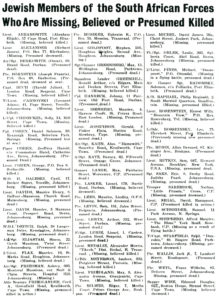 Among Ernest Willy’s personal papers is an “Application for Campaign Medals (1939 onwards)” form, completed and signed in June of 1946 by his father. Willy’s signature can be seen at the bottom of the form.
Among Ernest Willy’s personal papers is an “Application for Campaign Medals (1939 onwards)” form, completed and signed in June of 1946 by his father. Willy’s signature can be seen at the bottom of the form.
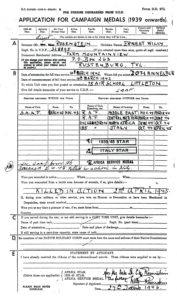 As in the United States (American Jews in World War II – The Story of 550,000 Fighters for Freedom – 1947), Canada (Canadian Jews in World War II – 19448), England (Henry Morris We Will Remember Them – A Record of the Jews Who Died in the Armed Forces of the Crown 1939 – 1945, in 1989 and 1994), a commemorative volume covering Jewish military service was published in South Africa. Released by the South African Jewish Board of Deputies in 1950, South African Jews in World War Two describes different facets of aspects of Jewish military service, and includes a Roll of Honour of the names of South African Jewish soldiers who were killed in action or died on active service. South African Jews in World War Two is stylistically akin to – and more detailed than – American Jews in World War II, as it includes photographs, a glossary, and an index, as well as a list of soldiers who were wounded or injured, and received military decorations.
As in the United States (American Jews in World War II – The Story of 550,000 Fighters for Freedom – 1947), Canada (Canadian Jews in World War II – 19448), England (Henry Morris We Will Remember Them – A Record of the Jews Who Died in the Armed Forces of the Crown 1939 – 1945, in 1989 and 1994), a commemorative volume covering Jewish military service was published in South Africa. Released by the South African Jewish Board of Deputies in 1950, South African Jews in World War Two describes different facets of aspects of Jewish military service, and includes a Roll of Honour of the names of South African Jewish soldiers who were killed in action or died on active service. South African Jews in World War Two is stylistically akin to – and more detailed than – American Jews in World War II, as it includes photographs, a glossary, and an index, as well as a list of soldiers who were wounded or injured, and received military decorations.
There, Ernest Willy’s name can be found on page “xii”, amidst the names of other South African Jewish soldiers who did not return.

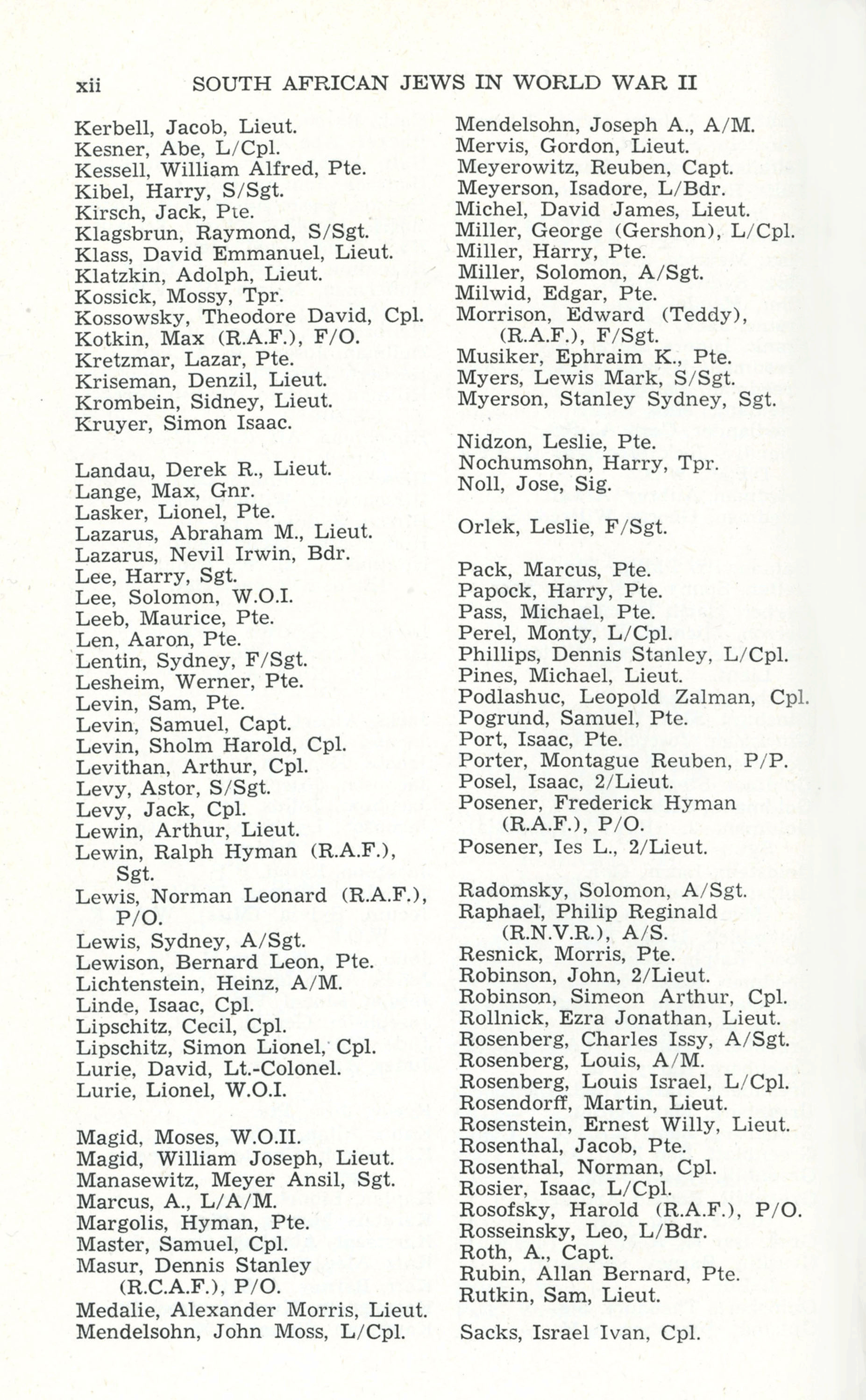 ______________________________
______________________________
The Flights and Combat Missions of Ernest Willy Rosenstein
This is the cover of Ernest Willy’s Pilot’s Log Book, the dimensions of which are 6 ¼ x 8 ½ inches.
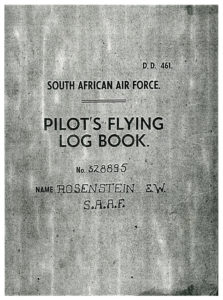
I’d considered posting scans of the Log Book’s pages, but then, decided not to. Instead, a much clearer “image” – in terms of visual legibility, in terms of a “picture” of the Mediterranean Air War in 1944, and as an appreciation for Ernest Willy’s experiences – can be gained from viewing the entries in transcribed format. So, all the Log Book entries are presented in the sequence and format in which Ernest Willy recorded them, with the following additions:
1) Though Ernest Willy only recorded an individual aircraft letter(s), (“N”) the full aircraft identifier is presented as it would have appeared on the plane itself. For example, the squadron code of a No. 185 Squadron Spitfire is presented as an italicized “GL * N”.
2) Ernest Willy’s post-mission comments (which he recorded in cursive script) are presented below the date of the mission, in italics. For some abbreviations, I’ve included some comments after Ernest Willy’s diary entries. These are italicized and appear in brackets. An example: “I.L.A.A. [Intermittent light anti-aircraft]”.
Reviewing the Log Book yields some interesting observations…
Ernest Willy’s Missions
Based on Ernest Willy’s Log Book entries, as well as the No. 185 Squadron Record of Work Carried out for early March, 1945 (the Log Book entries for that date are unavailable), Ernest Willy completed 245 flights – of all types – commencing with his assignment to No. 73 Operational Training Unit at Abu Sueir, Egypt, through his final mission on April 2, 1945. Prior to his assignment to No. 242 Squadron, he completed 78 familiarization and training flights, primarily in Spitfires (Marks I, V, and IX – some of which appear to have been tropicalized Spitfires, designated by “T”), with 22 flights in Hurricanes, 8 in Harvard trainers, and 1 each in an Argus and Hudson.
He completed 72 flights in 242 Squadron, and 97 flights in 185 Squadron.
Reviewing his Log Book reveals that among all 245 flights, only 16 missions eventuated in encounters with other aircraft. Of these 16 flights, only one mission (July 25, 1944) resulted in an encounter with an enemy plane. This was a Me-410 Hornisse which simply disappeared into clouds. The other 15 flights involved escort (C-47s, 1 B-26, and on two occasions a (captured?!) Fieseler Fi-156 Storch), or, interceptions of unidentified Allied aircraft.
Otherwise, when not engaged in Air Tests, his missions comprised dive-bombing and strafing, bomber escort, patrols, and weather reconnaissance missions.
Ernest Willy’s Spitfires
Ernest Willy flew at least six Spitfires he’d nicknamed “Naomes”, which he identified via a Roman numeral suffix. Ernest recorded missions in Naomes II and III while serving in Number 242 Squadron, and Naomes IV, V, and VI while serving in Number 185 Squadron. The existence of a “Naomes I” – (not specifically recorded in his Log Book!) – is implied. The other varied “Naomes-es” are noted in seven particular Log Book entries.
For No. 242 Squadron, it is impossible to specifically identify Naomes II and III.
Ernest Willy lists pilot “Barry Ware” as having bailed out of Naomes II on August 14, 1944. However, the “Squadron’s Summary of Events”, and, “Record of Work Carried Out”, for August 14 note that that there was no flying on that date. (This inaccuracy in Ernest Willy’s notes suggests that he recorded his diary entries some days after the events they chronicled.)
But… The Squadron’s Summary of Events for 16 August states, “Four uneventful patrols were our day’s operations. 1 Spitfire IX was Cat. II, pilot F/Sgt. Ware Aus. 420325 unhurt when the engine cut on take off immediately after becoming airborne. The aircraft crashed beyond the end of the runway into the scrub with a full 90 gallon overload tank but most fortunately did not catch fire. 21 operational sorties.” (F/Sgt. Ware was actually “John Barry Ware”, whose name can be found in the database of the National Archives of Australia.)
Unfortunately, it seems that No. 185 Squadron did not include the serials of its aircraft in the Record of Word Carried Out – at least for August, 1944. Thus, the serial of Naomes II may remain unknown. In any case, by correlating Ernest Willy’s Log Book entries to the ORBs, the plane was definitely “LE * P”.
Ernest Willy seems to have been assigned a “new” Spitfire IX a few days after August 16, naming this aircraft – his “new” “LE * P” – “Naomes III”.
Unlike the practice in 242 Squadron, for No. 185 Squadron, the ORBs for March and April list aircraft serials, but not (!) individual aircraft letters. The specific Spitfires Ernest flew during those months were Naomes IV, V, and VI, all of which were coded “GL * N”. During March, 1945, Ernest Willy most often flew MH982, followed by “GL * R”, EN196. (SM135, flown on 3/29, is also listed in Ernest Willy’s Log Book as “GL * N”. Was this the “second” No. 185 Squadron Spitfire coded “GL * N”, or, was this an incorrect diary entry?…)
Ironically, while Ernest regularly flew Spitfire MH982, he was lost in MH892.
The Loss of a Fellow Pilot: Flight Officer Nelson Myers, RAAF
Ernest Willy’s comment about the loss of Nelson Myers is very brief: “Nelson Myers went straight in.” Number 185 Squadron’s Summary of Events recounts this event in much more detail:
“A strafe on Radar Installations at CAP COURONNE was carried out at approximately 1045 hours by ten aircraft. Six attacked the GIANT WURZBURG obtaining many hits all over the bowl and buildings and undoubtedly knocking it out completely. The other four aircraft strafed the Coast Wather obtaining hits all over the antennae and buildings, 3 x 40 mm guns posts were silenced and buildings, billets and pill boxes around the target area were strafed. Very intense accurate flak of all calibres was encountered immediately on first approaching the area and two aircraft were lost, one, Pilot F/O N.L. Myers Aus. 413088 being seen to dive into the sea after he had called up on R/T to say, “He had had it, if he could not gain altitude,” he was not seen to leave the aircraft. The other Pilot F/O P.C.J. Strutt 137171 baled out at approximately 1050 hours and was later seen in his dinghy in the GULF OF FOS. He made an excellent bale out over the side. Later four aircraft went out on an A.S.R. search with a Catalina and what appeared to be a German A.S.R. launch was seen in the area, which made off into LAKE BERRE. An International call had been put out and acknowledged by the Hun so it appears most probably that F/O Strutt was picked up by them. 14 operational sorties. To-day has certainly lived up to the 13th melancholy superstition. Nelson Myers was the Squadron Sports Officer and a tower of strength at all games. Pete Strutt had previously been Parachute Officer and had recently assumed the duties of M.T. Officer. Their loss is a great blow to the Squadron.“
Born on January 8, 1922, F/Lt. Nelson Lorin Myers, 413088, was the son of Archibald and Henrietta Jane Myers, of 27 Anderton Street, Islington, Newcastle, New South Wales, Australia. Lost in Spitfire IX MH994, his name is commemorated on Panel 16, Column 1, of the Malta Memorial.
As hoped, F/O Strutt was captured. He survived the war as a POW at Stalag Luft III.
And so, here are Ernest Willy’s Log Book entries…
No. 73 Operational Training Unit (Abu Sueir, Egypt)
December, 1943
12/21 – Spitfire Ia N3283 – Exercise 1 – Reconnaissance
12/22 – Spitfire Ia X4274 – Exercise 1 – Reconnaissance
12/24 – Spitfire Ia X4945 – Exercise 1 – Reconnaissance
12/27 – Spitfire Ia P9557 – Exercise 5 – Forced Landings
12/27 – Spitfire Ia P9557 – Exercise 4 – Formation (Close, Battle)
12/27 – Spitfire Ia X4945 – Exercise 5 – Forced Landings; Cloud Flying
12/28 – Spitfire VcT EF641 – Ground Controlled Interception
12/29 – Spitfire VcT EF641 – Exercise 7 – Formation and Cine
12/29 – Spitfire VcT JK842 – Exercise 9 / Exercise 14 – Formation and Cine
12/30 – Spitfire Ia P9557 – Exercise 13 – Cross-Country (Base – Maryut – Base)
12/31 – Spitfire VcT EF641 – Exercise 3 – Oxygen Climb 18,000 feet
12/31 – Spitfire Ia P9557 – Exercise 1 / Exercise 8 – Low Flying
12/31 – Spitfire VcT JL379 – Baltimore Interception
February, 1944
2/5 – Harvard EX153 – Base – Alexandria (with W/O Rawlson)
2/5 – Harvard EX153 – Alexandria – Base
2/7 – Harvard EX122 – Base – Heliopolis (with F/O Letheridge)
2/7 – Harvard EX122 – Heliopolis – Base (with F/O Letheridge)
2/7 – Harvard EX137 – General Flying (with Lt. Chaplin)
2/8 – Spitfire Ia P9334 – Exercise 1 / Exercise 2 – Reconnaissance
2/8 – Harvard EX137 – Base – Heliopolis
2/8 – Harvard EX137 – Heliopolis – Base
2/9 – Spitfire Ia X4274 – Exercise 5 Forced Landings / Exercise 8 Low Flying
2/9 – Spitfire Vc ES336 – Ground Controlled Interception
2/9 – Spitfire Vc ES336 – Exercise 11 Spinning / Cine
2/9 – Spitfire Ia X4274 – Exercise 11 – Aerobatics
2/10 – Spitfire Ia P9334 – Exercise 11 – Aerobatics
2/10 – Spitfire Ia X4274 – Exercise 6 – Oxygen Climb to 26,000 feet
2/12 – Spitfire Vc EF641 – Exercise 14 – Individual Attacks Cine
2/14 – Spitfire VcT JL242 – Exercise 15 – Air Combat
2/14 – Spitfire Vc ES336 – Exercise 28 – Air to Air
2/15 – Spitfire Vb AA870 – Exercise 18 – Individual Attacks
2/16 – Spitfire Vb ER637 – Exercise 21 – Battle Formation
2/16 – Spitfire VcT JL242 – Exercise 22 – Air Combat (Advanced)
2/16 – Spitfire Vc EF641 – Exercise 21 / Exercise 22 – Battle Formation / Air Combat
2/17 – Spitfire VcT MA888 – Exercise 21 – Battle Formation
2/17 – Spitfire Vb FR637 – Exercise 21 – Battle Formation
2/19 – Spitfire IX LZ994 – Exercise 25 – Shadow Firing
2/21 – Spitfire IX LZ944 – Exercise 23 – Air to Ground
2/21 – Spitfire VcT JL306 – Exercise 25 – Shadow Firing
2/21 – Spitfire IX LZ994 – Exercise 23 – Air to Ground
2/22 – Spitfire VcT JL306 – Exercise 27 – Shadow Firing
2/22 – Spitfire Vb AA870 – Exercise 8 – Exercise 5 – Exercise 11
2/24 – Spitfire Vb AA870 – General Flying
2/25 – Harvard EX122 – Exercise 29 – Final Beat-Up
Mediterranean-Middle East Communication Squadron (Bari, Italy)
March, 1944
3/12 – Hurricane 122 – General Reconnaissance
3/14 – Hurricane 642 – Bari – Termoli – Vasto – Bari
3/15 – Hurricane 642 – Bari – Foggia – Bari
3/19 – Hurricane 624 – Bari – Termoli – Bari
3/21 – Hurricane 624 – Bari – Grottaglie – Vasto – Termoli – Bari
3/29 – Hurricane 642 – Bari – Termoli – Bari
3/31 – Hurricane 642 – Bari – Foggia – Vasto
April, 1944
4/3 – Hurricane 642 – Vasto – Bari
4/4 – Hurricane 624 – Bari – Foggia – Vasto – Bari
4/5 – Hurricane 624 – Bari – Foggia – Vasto – Bari
4/7 – Hurricane 624 – Bari – Foggia – Vasto – Bari
4/9 – Hurricane 624 – Bari – Foggia – Vasto – Bari
4/11 – Hurricane 110 – Bari – Foggia – Vasto – Termoli – Bari
4/14 – Hurricane 624 – Bari – Foggia – Vasto – Bari
4/15 – Hurricane 624 – Bari – Foggia – Vasto – Bari
4/18 – Hurricane 110 – Bari – Foggia – Bari
4/19 – Hurricane 624 – Air Test
4/19 – Spitfire Vb EP645 – Air Rest
4/21 – Spitfire Vb EP645 – Aerobatics
4/21 – Fairchild Argus FZ773 – Local (Sgt. Compton and LAC Schofield)
4/22 – Hurricane 642 – Bari – Foggia – Bari
4/23 – Spitfire Vb EP645 – Bari – Termoli – Bari
4/26 – Hurricane 860 – Bari – Foggia – Bari
4/29 – Hurricane 110 – Air Test
4/30 – Hurricane 860 – Bari – Foggia – Vasto – Bari
May, 1944
5/1 – Hurricane 110 – Bari – Naples
5/2 – Hudson “P” – Naples – Vasto (F/O Burliss)
Wing Training Flight (Cannae, Italy)
5/19 – Spitfire “E8” – Sector Reconnaissance
5/21 – Spitfire “A7” – Aerobatics
5/21 – Spitfire “A4” – Aerobatics
5/27 – Spitfire “A5” – Battle Formation – Tail Chase
5/28 – Spitfire “E3” – Jumping – Aerobatics
5/30 – Spitfire “E1” – Formation
Number 242 Squadron (Poretta, Corsica)
“Toujours Pret” – French, for “Always ready”
 June, 1944
June, 1944
6/21 – Spitfire IX “LE * Z” – Familiarity on Type / Reconnaissance
6/22 – Spitfire IX “LE * Z” – General Flying with Overload
6/23 – Spitfire IX “LE * Z” – Formation Flying
6/24 – Spitfire IX “LE * Z” – Sweep (south of Florence)
6/25 – Spitfire IX “LE * V” – Escort (Genova)
6/26 – Spitfire IX “LE * Z” – Escort (Genova)
6/26 – Spitfire IX “LE * Z” – Sweep (Bologna area)
6/27 – Spitfire IX “LE * N” – Escort (sweep Bologna area)
6/27 – Spitfire IX “LE * Z” – Formation Flying & Cine
6/29 – Spitfire IX “LE * Z” – Sweep (Bologna – Florence area)
Very heavy accurate flak
6/30 – Spitfire IX “LE * Z” – Sweep (north of Bologna)
Chased a couple of Spits around the sky
6/30 – Spitfire IX “LE * P” – Sweep (Bologna area)
“Naomes II”
July, 1944
7/1 – Spitfire IX “LE * P” – Sweep (Bologna – Parma area)
7/2 – Spitfire IX “LE * P” – Sweep (Bolgona area)
Heavy flak over 3 towns
7/3 – Spitfire IX “LE * N” – Sweep (Reggio area)
Chased 50+ Thunderbolts – bags of fun
7/5 – Spitfire IX “LE * P” – Sweep (Ferrara area)
7/6 – Spitfire IX “LE * P” – Bomber Escort (Bologna)
Hit by flak over Bologna aerodrome
7/7 – Spitfire IX “LE * P” – Bomber Escort (Collecchio)
I brought a straggling B-26 back to base
7/8 – Spitfire IX “LE * P” – Pre Night-Flying Air Test
7/10 – Spitfire IX “LE * Q” – Bomber Escort (Cermona)
Very accurate bombing
7/14 – Spitfire IX “LE * A” – Practice Flying
7/14 – Spitfire IX “LE * A” – Practice Flying
7/16 – Spitfire IX “LE * P” – Bomber Escort (near Leghorn)
7/16 – Spitfire IX “LE * P” – Sweep (Piacenza area)
Bounced by a couple of Thunderbolts
7/17 – Spitfire IX “LE * P” – Bomber Escort (north of Genoa)
7/18 – Spitfire IX “LE * P” – Patrol (over Corsica – 20,000 feet)
7/21 – Spitfire IX “LE * P” – Patrol (over Corsica – 15,000 feet)
7/22 – Spitfire IX “LE * P” – Patrol (over Corsica – 20,000 feet)
7/25 – Spitfire IX “LE * M” – Patrol (over Corsica – 20,000 feet)
7/25 – Spitfire IX “LE * P” – Patrol (over Corsica – 15,000 feet)
Saw a Me 410 – couldn’t catch up – disappeared in cloud base
7/27 – Spitfire IX “LE * R” – Patrol (over Corsica – 26,000 feet)
7/29 – Spitfire IX “LE * P” – Patrol (over Corsica – 20,000 feet)
7/29 – Spitfire IX “LE * P” – Cannon and R/T Test
7/29 – Spitfire IX “LE * U” – Patrol (over Corsica – 15,000 feet)
Vectored onto a Catalina at 50 ft.
August, 1944
8/1 – Spitfire IX “LE * C” – Saint Catherine – Calenzano
8/1 – Spitfire IX “LE * U” – Patrol (over Corsica – 15,000 feet)
8/4 – Spitfire IX “LE * Y” – Patrol (over Corsica – 20,000 feet)
Were vectored onto a P.R.U. Lightning
8/6 – Spitfire IX “LE * Q” – Air Test
8/6 – Spitfire IX “LE * F” – Sweep (Turin area)
8/6 – Spitfire IX “LE * Z” – Saint Catherine – Calenzana
8/8 – Spitfire IX “LE * Q” – Patrol (over Corsica – 20,000 feet)
Were vectored onto 3 French Spits
8/9 – Spitfire IX “LE * R” – Area Cover (Milan)
8/10 – Spitfire IX “LE * P” – Air Test
8/11 – Spitfire IX “LE * P” – Patrol (over Corsica – 15,000 feet)
8/11 – Spitfire IX “LE * B” – Patrol (over Corsica)
Engine started missing at 12,000 ft. – Bags of misfires on the way home.
8/12 – Spitfire IX “LE * P” – Strafing Nice Radar Station
A shaky do – came down from 5000 ft to strafe
8/13 – Spitfire IX “LE * P” – Strafing – Marseille Radar Station
Nelson Myers went straight in
8/14 – Spitfire IX “LE * C” – Calenzana – Elmas – Sardinia
Barry Ware pranged “Naomes II” – He bailed out
8/15 – Spitfire LFVIII JG257 – Elmas Calenazna
8/16 – Spitfire IX “LE * Y” – Beach-Head Patrol (Frejus)
8/17 – Spitfire IX “LE * B” – Beach-Head Patrol (Frejus)
8/18 – Spitfire IX “LE * N” – Beach-Head Patrol (Frejus)
Returned with no oil pressure
8/18 – Spitfire IX “LE * F” – Air Test
8/19 – Spitfire IX “LE * Z” – Beach-Head Patrol (Frejus)
8/19 – Spitfire VIII “LE * P” – Beach-Head Patrol (Frejus)
“Naomes III”
8/20 – Spitfire VIII “LE * P” – Beach-Head Patrol (Frejus)
8/20 – Spitfire VIII “LE * P” – Beach-Head Patrol (Frejus)
Were bounced by Lightnings
8/19 – Spitfire VIII “LE * P” – Beach-Head Patrol (Frejus)
8/21 – Spitfire VIII “LE * P” – Beach-Head Patrol (Frejus)
8/22 – Spitfire IX “LE * M” – Beach-Head Patrol (Frejus)
8/23 – Spitfire VIII “LE * P” – Calenzana – Frejus
(Frejus Airfield, Riviera, France)
8/24 – Spitfire IX “LE * H” – Sweep (Marseille area)
8/26 – Spitfire VIII “LE * P” – Patrol (Cannes – Marseille)
8/27 – Spitfire VIII “LE * P” – Patrol (Cannes –Nice)
8/30 – Spitfire VIII “LE * P” – Patrol (Cannes – Marseille)
Flak from our own guns over Marseille
8/31 – Spitfire VIII “LE * P” – Patrol (Marseille Area)
Exhaust stub came off
September, 1944
(Montelimar, France)
9/1 – Spitfire IX “LE * S” – Sweep (Turin area)
September mission (date unknown) – Sweep (Lyon – Turin)
September mission (date unknown) – Frejus – Montelimar
September mission (date unknown) – Montelimar – Le Valone
September mission (date unknown) – Le Valone – Calvi (Corsica)
September mission (date unknown) – Calvi – Elmas (Sardinia)
October, 1944
Number 185 Squadron (Fano, Italy)
“Ara Fejn Hu” – Maltese, for “There it is”
 10/31 – Spitfire IX “GL * S” – Practice Flying
10/31 – Spitfire IX “GL * S” – Practice Flying
10/31 – Spitfire IX (“clipped-wing IX”) “GL * H” – Dive-Bombing
Enemy stronghold near Forli – Russi road
November, 1944
11/4 – Spitfire IX “GL * E” – Dive-Bombing
Enemy troop concentrations south of Ravenna
11/5 – Spitfire IX “GL * N” – Dive-Bombing and Strafing
Enemy concentration on Forli aerodrome – “Naomes IV”
11/6 – Spitfire IX “GL * K” – Dive-Bombing
Bridge on Rimini – Ravenna road just outside Ravenna L.I.A.A. [Light intermittent anti-aircraft]
11/8 – Spitfire IX “GL * N” – Dive-Bombing
Nebelwerfers just north of Forli
11/9 – Spitfire IX “GL * N” – Dive-Bombing
Enemy troop concentrations south of Fienca [?] L.A.A. [Light anti-aircraft]
11/16 – Spitfire IX “GL * N” – Dive-Bombing
Enemy strongpoint in a house near Fienca [?] I.L.A.A. [Intermittent light anti-aircraft]
11/17 – Spitfire IX “GL * N” – Fano-Florence
11/21 – Spitfire IX “GL * K” – Dive-Bombing
Enemy gun positions in a field south of Bologna I.L.A.A. [Intermittent light anti-aircraft]
11/26 – Spitfire IX “GL * F” – Dive-Bombing
Weather U/S – returned to base
(Florence, Italy)
December, 1944
12/1 – Spitfire IX “GL * L” – Weather Reconnaissance
Ended up about 20 miles north of the Po – 10/10 everywhere
12/2 – Spitfire IX “GL * N” – Dive-Bombing
Bombed gun positions just south of Bologna – very intense light flak
12/7 – Spitfire IX “GL * R” – Practice Cloud Flying
Very Golly!
12/10 – Spitfire IX “GL * N” – Dive-Bombing
Bombed gun positions south-west of Bologna – M.L.A.A. [Moderate light anti-aircraft]
12/15 – Spitfire IX “GL * N” – Dive-Bombing and Strafing Northern Italy
Bombed petrol dump at Fidenza – flames up to 4000 ft – 4 D.H. [Direct hits]
12/21 – Spitfire IX “GL * N” – Practice Cloud Flying
Chased a vapor trail for a bit – no joy
12/22 – Spitfire IX “GL * N” – Dive-Bombing
Bombed ammo dump at Riolunato – M.L.A.A. [Moderate light anti-aircraft]
12/25 – Spitfire IX “GL * L” – Dive-Bombing and Strafing
Bombed gun positions north of Tossignano – L.I.A.A. [Light intermittent anti-aircraft]
12/26 – Spitfire IX “GL * N” – Dive-Bombing and Strafing
Bombed gun positions south of Bologna – No A.A.
12/26 – Spitfire IX “GL * K” – Dive-Bombing and Strafing
Bombed enemy head-quarters at Marzabatto [?] – No A.A.
12/27 – Spitfire IX “GL * T” – Air Test
12/28 – Spitfire IX “GL * N” – Escorting C-47s
Escorted 4 C-47s to partisan forces in the hills north of Spezia
12/29 – Spitfire IX “GL * N” – Dive-Bombing
Bombed road – bridge north of Aulla – M.L. and H.A.A. [Moderate to light and heavy anti-aircraft]
12/30 – Spitfire IX “GL * N” – Dive-Bombing
Bombed same bridge again – forced landed at Pisa – H.A.A. [Heavy anti-aircraft]
12/30 – Spitfire IX “GL * N” – Pisa-Pontadera
Forced landed again with more engine trouble.
(Pontadera, Italy)
January, 1945
1/2 – Spitfire IX “GL * K” – Escorting C-47s
Escorted 6 C-47s to partisan forces north of Piacenza
1/3 – Spitfire IX “GL * T” – Dive-Bombing
Bombed road-bridge northwest of Bologna – No A.A.
1/4 – Spitfire IX “GL * N” – Dive-Bombing
Bombed heavy gun west of Lasso-Bolognese – L.A.A. [Light anti-aircaft]
1/7 – Spitfire IX “GL * N” – Dive-Bombing
Returned – weather U/S – M.H.A.A. near Spezia
1/9 – Spitfire IX “GL * N” – Dive-Bombing and Strafing
Bombed and strafed gun positions south-east of Bologna
1/10 – Spitfire IX “GL * N” – Dive-Bombing and Strafing
Bombed and strafed gun positions just south of Spezia – 4 D.H. [Direct Hits]
1/15 – Spitfire IX “GL * N” – Dive-Bombing and Strafing
Bombed and strafed enemy command post near Lasso Bolognese
1/17 – Spitfire IX “GL * F” – Dive-Bombing and Strafing
Bombed a fuel distillery north of Modena – strafed 2 R.R. tracks
1/18 – Spitfire IX “GL * K” – Weather Reconnaissance
Piacenza – Bologna – Spezia
1/18 – Spitfire IX “GL * N” – Pontadera – Jesi
Wrinkled wing
1/19 – Spitfire LFIX PT543 – Jesi – Fabriano – Jesi
Weather – U/S
1/20 – Spitfire LFIX PT543 – Jesi – Pontadera
1/21 – Spitfire IX “GL * K” – Weather Reconnaissance
Spezia – Reggio – Bologna
1/27 – Spitfire IX “GL * K” – Dive-Bombing and Strafing
Bombed and strafed food and equipment stores north of Bologna
1/30 – Spitfire IX “GL * K” – Dive-Bombing and Strafing
Bombed and strafed petrol dumps at Casalmaggiore – L.A.A. [Light anti-aircraft]
1/31 – Spitfire IX “GL * M” – Dive-Bombing
Bombed ammo dump north of Bologna – flames up to 4000 ft.
February, 1945
2/10 – Spitfire IX “GL * N” – Dive-Bombing and Strafing
Close support on tanks north-west of Massa “Naomes V”
2/11 – Spitfire IX “GL * N” – Dive-Bombing (attempt)
Hood came off – landed – took off again but was too late.
2/13 – Spitfire IX “GL * N” – Dive-Bombing
Bombed below cloud at 3000 ft. – Ammo dump east of Aulla
2/13 – Spitfire IX “GL * N” – Dive-Bombing and Strafing
Bombed and strafed M/T repair depot at Bazzano – D.H. [Direct Hit]
2/14 – Spitfire IX “GL * B” – Patrol and Area Cover
Uneventful. [Lost Sgt. Spruce]
2/15 – Spitfire IX “GL * N” – Dive-Bombing and Strafing
Bombed and strafed M/T repair depot at Sassuolo – L.A.A. [Light anti-aircraft]
2/15 – Spitfire IX “GL * N” – Pisa – Pontadera
2/16 – Spitfire IX “GL * K” – Patrol
Uneventful
2/17 – Spitfire IX “GL * P” – Dive-Bombing and Strafing
Bombed and strafed 3 trucks north of Aulla – no direct result
2/19 – Spitfire IX “GL * R” – Weather Reconnaissance
Uneventful – Castelnuovo – Parma – Bologna
2/20 – Spitfire IX “GL * R” – Dive-Bombing
Bombed road bridge
2/20 – Spitfire IX “GL * R” – Pisa – Pontadera
[Freiherr V. Gablenz) (One Hun General and 30 men)
2/22 – Spitfire IX “GL * H” – Dive-Bombing and Strafing
Close support – bombed and strafed stores at Pavullo (confirmed)
2/22 – Spitfire IX “GL * S” – Armed Reconnaissance
Dive bombed road bridge at Vignola – saw only horse-carts I.L.A.A. [Intermittent light anti-aircraft]
2/23 – Spitfire IX “GL * T” – Armed Reconnaissance
Peter Mayne bailed out north of Pisa
2/23 – Spitfire IX “GL * T” – Pisa – Pontadera
Search
2/24 – Spitfire IX “GL * R” – Escorting C-47s
Uneventful
2/24 – Spitfire IX “GL * C” – Air Test
Aircraft U/S
2/25 – Spitfire IX “GL * N” – Air Test
Missing [engine]
2/26 – Spitfire IX “GL * S” – Bombing (attempt)
A/C U/S
2/26 – Spitfire IX “GL * N” – Air Test
Worse than ever
2/27 – Spitfire IX “GL * K” – Escorting C-47s
Returned early
(Missing page in log-book? – Entries for March 2 through March 14 are based on “Word Carried Out” in ORB.)
March, 1945
3/2 – Spitfire MH982 “GL * N” – Attacking explosive stores at P.939878
3/3 – Spitfire ME982 “GL * N” – Attacking stores depot at P.996150
3/4 – Spitfire EN196 “GL * R” – Long-range escort of 3 C-47s dropping supplies in Partisan territory
3/6 – Spitfire MH892 – Attacking enemy-occupied village of Zocca
3/7 – Spitfire MH982 *GL * N” – Attacking fuel dump between “Y” road junction at P785323
3/8 – Spitfire MH982 “GL * N” – Attacking ammo dump at southeast outskirts of Bologna
3/9 – Spitfire RK920 – Long-range escort of 6 C-47s carrying supplies to Partisan territory
3/10 – Spitfire MH982 “GL * N” – Attacking motor-transport repair depot at L.451551
3/11 – Spitfire EN196 “GL * R” – Escorting a Fiesler Storck to P.9345
3/12 – Spitfire MH982 “GL * N” – Shipping reconnaissance up coast past Sestri Leavnte
3/13 – Spitfire MH982 “GL * N” – Attacking telephone exchange at L.515536
3/14 – Spitfire EN196 “GL * R” – Escorting Fiesler Storck in area P.9343
3/14 – Spitfire MH982 “GL * N” – Attacking ammo and fuel dump at L.681519
(Log-book resumes on 3/15)
3/15 – Spitfire IX “GL * N” – Air Test (Reflex tests)
3/17 – Spitfire IX “GL * T” – Air Test (Reflex tests)
3/17 – Spitfire IX “GL * P” – Air Test (Reflex tests)
3/17 – Spitfire IX “GL * P” – Air Test (Reflex tests)
3/17 – Spitfire IX “GL * P” – Air Test (Reflex tests)
3/17 – Spitfire IX “GL * P” – Air Test (Reflex tests)
3/18 – Spitfire IX MH982 “GL * N” – Dive Bombing and Strafing
Bombed and strafed ammo dump at Pontremoli – got a D.H. {Direct Hit]
3/19 – Spitfire IX EN196 “GL * R” – Escorting C-47s
Escorted 2 C-47s to partisan forces east of Genova
3/20 – Spitfire IX MH982 “GL * N” – Dive Bombing
Bombed Bersaglieri “H.Q.” just north of Castelnuovo
3/21 – Spitfire IX MH982 “GL * N” – Dive-bombing and Strafing
Bombed and strafed fuel dump at Coloma [?]
3/23 – Spitfire IX EN196 “GL * R” – Escorting C-47s
Escorted 6 C-47s to partisans near Borgo in pretty bad weather
3/24 – Spitfire IX EN196 “GL * R” – Dive Bombing and Strafing
Bombed and strafed fuel oil field on Salsomaggiore – got a lot of smoke
3/25 – Spitfire IX EN196 “GL * R” – Dive Bombing and Strafing
Bombed and strafed the same oil field as yesterday
3/25 – Spitfire IX MH982 “GL * N” – Air Test
“Naomes VI” Absolutely perfect!
3/29 – Spitfire IX SM135 “GL * N” [2nd “GL * N” of 185 Squadron, or, simply a mistake in log-book?] – Dive Bombing and Strafing
Bombed and strafed fuel distillery at Fiorenzuola – a near miss
3/30 – Spitfire IX “GL * P” – Practice Bombing
3/30 – Spitfire IX EN196 “GL * R” – Dive Bombing and Strafing
Bombed and strafed fuel depot at Fidenza – tons of fires started
3/30 – Spitfire IX “GL * N” – Air Test
“Naomes V” back again with a new engine.
3/31 – Spitfire IX MJ577 “GL * B” – Bombing
Jettisoned – engine trouble
April, 1945
4/2 – Spitfire IX MH892 Dive-Bombing (Methane Gas Plant at Fontana, Italy)
“Missing, believed killed – Aircraft dived in, in flames”
Total Operational Hours: 176:10
Grand Total Flying Hours: 556:35
______________________________
And so, a story that ended too early has been told.
Perhaps it is fitting to conclude with fewer words than many:
.ת.נ.צ.ב.ה.
Tehé Nafshó Tzrurá Bitzrór Haḥayím
May his soul be bound up in the bond of everlasting life.
______________________________
References
Again, my sincere thanks to Robert B. Gill, for providing me with material about Ernest Willy Rosenstein, and, documenting the life of Willy Rosenstein.
______________________________
Willy Rosenstein and Ernest Willy Rosenstein (General)
Matzeva of Ernest Willy Rosenstein (at FindAGrave)
Willy Rosenstein (at Wikipedia)
Willy Rosenstein (at geni)
Willy Rosenstein (at Alemannia Judaica)
Willy Rosenstein (at Wikiwand)
Casualty List in South African Jewish Times
– Lieutenant Harry Noel Greenberg –
France Crashes – Dakota IV KN332 (crew list and accident details, at France Crashes)
Aviation Safety Net – Dakota IV KN332 (at Aviation Safety)
Other References
No. 185 Squadron, RAF – history (motto (Maltese): Ara fejn hu – “Look where it is”) (at Wikipedia)
No. 185 Squadron, RAF – emblem (at RAF Heraldry Trust)
No. 242 Squadron, RAF – history (motto (French): Toujours prêt – “Always ready”) (at Wikipedia)
No. 242 Squadron, RAF – emblem (at 1000 Flags Co UK)
F/Lt. Nelson Lorin Myers (Roll of Honour Circular at Australian War Memorial)
RAF WW II Acronyms (at WW2F)
RAF WW II Acronyms (at Key Publishing Forum)
Fontanatredda, Italy (at Wikipedia)
Books
Brent, Winston, 85 Years of South African Air Force – 1920-2005, Freeworld Publications, Inc., Nelspruit, South Africa, 2005
Green, William, Famous Fighters of the Second World War, Hanover House, New York, N.Y., 1958.
Hooten, Ted, and Ward, Richard, Supermarine Spitfire Mk. I-XVI in RAF – SAAF – RAAF – RNZAF – RCAF & Foreign Service, Arco Publishing Company, Inc., New York, N.Y., 1968
Martin, Henry J., and Orpen, Neil, South African Forces, World War II. Vol. 6, Eagles Victorious: The Operations of the South African Forces Over the Mediterranean and Europe, in Italy, the Balkans and the Aegean, and from Gibraltar and West Africa, Purnell, Cape Town, South Africa, 1977
Rosmarin, Ike, Inside Story, W.J. Flesch & Partners (Pty.) Ltd., Cape Town, South Africa, 1990
Scutts, Jerry, Spitfire in Action, Squadron / Signal Publications, Carrollton, Texas, 1980
Prisoners of War – Naval and Air Forces of Great Britain and The Empire, 1939-1945, His Majesty’s Stationary Office, 1945 (Reprint by J.B Hayward and Son, Polstead, Suffolk, England)
South African Jews in World War Two, Eagle Press, South African Jewish Board of Deputies, Johannesburg, South Africa, 1950.

